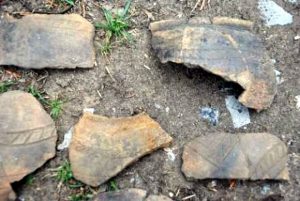Excavations on a hill near Viborg in West Denmark revealed remains of a 18 metres long Iron Age house that burnt down. The scorched layers of earth have protected the site for almost 2000 years.

The house dates back to around 100 AD during the Iron Age. the site was located six months ago, when a boy came in to the Viborg Museum with some shards of pottery that were clearly from the Iron Age, but as there was no trace of fire on them, the archaeologists thought it was a grave in a field that had been ploughed. Test excavations revealed that it was a house, that on the course of following research was unearth at its full extent.

According to the researchers the house was larger than the typical Iron Age home, at 18 metres long by 5.5 metres wide. It would have had a great view of the farm with close proximity to water. The size of the house indicates that there were between seven and ten family members with living quarters in the west and animals in the east. The length of the house could indicate that they had more animals than is usual. There are no traces of burnt animals or people in the house, and we would’ve found them if they were there. If it was the summer, then the animals were probably out in the fields. If it was in winter, then perhaps they got them out. The house probably burnt down during the summer, and the animals were the only thing that they managed to save.

The archaeologists have found three clay pots inside the house. The contents will now be studied further. A recess inside the house was probably used to store corn. Radiocarbon analyses of the corn should give a more precise age for the house. Remnants of old animal stalls were uncovered in the eastern end of the house. They were 80 to 90 centimetres wide, and for smaller animals than we have today. Archaeologists believe that they might have been goats or pigs. According to the experts without the fire, these unique details could not be presently seen. It preserved the house exactly as it was used in the Iron Age.

(after Jørgen Andersen, Ida Westh Hansen via Science Nordic)